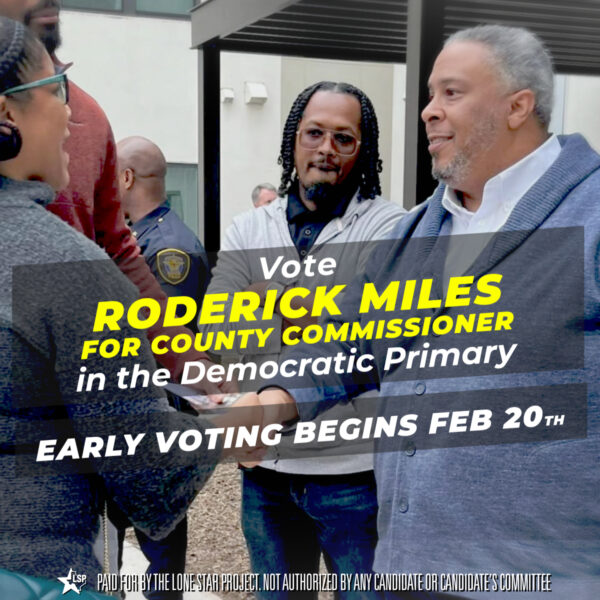All of the new districts coming to Texas should be used to bring racial, ethnic, and political balance to the Texas Congressional delegation. Any effort to draw new or additional Republican held seats will further undermine Texas minorities and push the Congressional delegation even further outside the range of reasonable balance.
The current DeLay-inspired map was intentionally drawn to heavily favor Republicans. To achieve their partisan goal, Texas Republican state leaders undermined the minority vote. In fact, the most striking feature of the current Congressional map is not its overt partisanship, but rather its dramatic under-representation of Hispanic and African-American voting strength.
In region after region, minority residents of Texas are packed into as few districts as possible to concentrate their influence in a minimum number of minority districts. The remaining minority population is broken apart into as many different districts as possible to dilute voting strength.
What is fair?
All four of the new Congressional districts in Texas should be used to restore minority voting strength and to reflect the growing Hispanic and African-American populations.
- Hispanic growth must be acknowledged with new districts
Certainly, the Hispanic population growth warrants the creation of at least two new Hispanic opportunity districts – perhaps one in Dallas County and one somewhere in the region of the state between south Travis County and the border. - African-American population voting strength should be restored and enhanced to reflect its dramatic growth
Lost in the attention paid to Hispanic population growth is the fact that the African-American population in Texas is also growing at a very fast rate. In fact, the African-American population is growing at nearly double the rate of Anglos. In the current map, African-American voting strength is badly undermined, particularly in Tarrant County and in the Houston/Beaumont area. The large concentrations of African-American populations stranded in Republican districts in Tarrant County and in the Houston-to-Beaumont area warrant relief and new districts could be added in each area.
Today, the New York Times made this point succinctly when it reported: “But population gains in the south and west were driven overwhelmingly by minorities, particularly Hispanics, and the new districts, according to the rules of redistricting, will need to be drawn in places where they live, opening potential advantages for Democrats, who tend to be more popular among minorities” (New York Times, December 21, 2010).
New Texas Districts due to Hispanic and AA Population Growth
The only reason Texas is gaining any new Congressional seats is because of the high rate of growth in the Hispanic and African-American populations.
- 435 Congressional seats are apportioned among the states based on their relative population growth. States whose population stays consistent with the rate of national growth do not lose or gain seats. States whose population lags behind the national growth rate can lose seats. States whose population growth exceeds the national rate can gain.
- The national population growth rate according to the new Census is 9.7 percent. Texas more than doubled the national rate with 20.6 percent growth. As a result, Texas is awarded four new seats. Only Florida grew fast enough to warrant a gain of even two seats.
So why was the Texas growth so dramatic and who is responsible for it?
- Hispanic and African-American populations grew at remarkable rates. According to previous Census Bureau projections, the Texas Hispanic population increased by 33 percent, far exceeding the national growth rate. The African-American population increased by 16.2 percent also significantly exceeding the national growth rate (U.S. Census Bureau).
- Conversely, Census Bureau projections show that the population of Anglo and non-Hispanic or African American minorities in Texas grew at a rate of only 7.5, less than the national rate (U.S. Census Bureau). The rate of Anglo growth was just 5.4%.
- Therefore, if the entire population of Texas had grown at only the rate of Anglos, then Texas would not be receiving any new Congressional seats.
Current Map Undermines Texas Minority Voting Strength
To understand the extent to which Texas State leaders undermined minority voters to assure the election of Republicans, consider these facts:
- Minority Voter Impact Minimized
Approximately 50 percent of the Texas population is made up of minority residents, yet minorities have an electoral impact in no more than 10 of the 32 Congressional districts. - African-Americans stranded in hostile GOP districts
Over 60 percent of African-Americans living in Texas reside in districts currently represented by Republicans in Congress, yet no current Texas Republican grades higher than an “F” by the NAACP in its “Civil Rights Federal Legislative Report Card” for the first session of the 111th Congress (NAACP Score Card, 2009). - Hispanics stranded in hostile GOP districts
Over 50 percent of the Latino population in Texas resides in districts represented by Republicans, yet all the current Republican Members of Congress failed to support the DREAM Act (U.S. House Roll Call vote #625) – which would allow children brought to this country by immigrants to earn citizenship through a rigorous program that includes required military service, public service or going to college. - Minorities cracked into many Republican districts
Minority residents make up over 30 percent of the population in 19 of the 23 Republican-held Congressional districts. Yet, in none of these districts is the minority vote large enough to impact the election. Only three Republican districts have a minority population greater than 50 percent (Canseco – CD23, Farenthold – CD27, Sessions – CD32). - Minorities packed into just a few Democratic districts
Minority residents make up over 80 percent of the population in eight of the nine districts now held by Democrats. Only Austin-based CD25 represented by Lloyd Doggett has less than 80 percent minorit y residents (U.S. Census Bureau, American FactFinder).
Undermining Minority Vote Helps Republicans
By dramatically undermining the voting strength of minority citizens, Texas Republicans are able to win a disproportionate number of Congressional seats.
- Congressional districts under-perform compared to Democrats statewide
Democrats, even while fielding a number of underfunded candidates for statewide office since 2002, have averaged receiving 42 percent of the vote over the last decade. Yet, Democrats currently hold only 9 of 32 (28.2 percent) of Texas Congressional districts. - Congressional districts over-perform compared to Republicans statewide
Republicans, while enjoying incumbency and an overwhelming financial advantage in statewide races, have averaged receiving only 54 percent of vote over the last decade. Yet, Republicans currently hold 23 of 32 (78.3 percent) of Texas Congressional districts. - Millions of Texas minorities stranded in North Texas GOP districts
Dallas County has been carried by top-of-the-ticket Democratic candidates for three election cycles in a row. The County contains two complete districts and significant portions of three others. However, only one Dallas-based district is held by a Democrat (Eddie Bernice Johnson – CD30). In fact, CD30 is the only Democratic-held Congressional district north of Austin, even though North Texas has one of the largest minority populations in the country. The DFW area is a textbook example of packing and cracking minority voters in order to minimize their impact on congressional elections.



